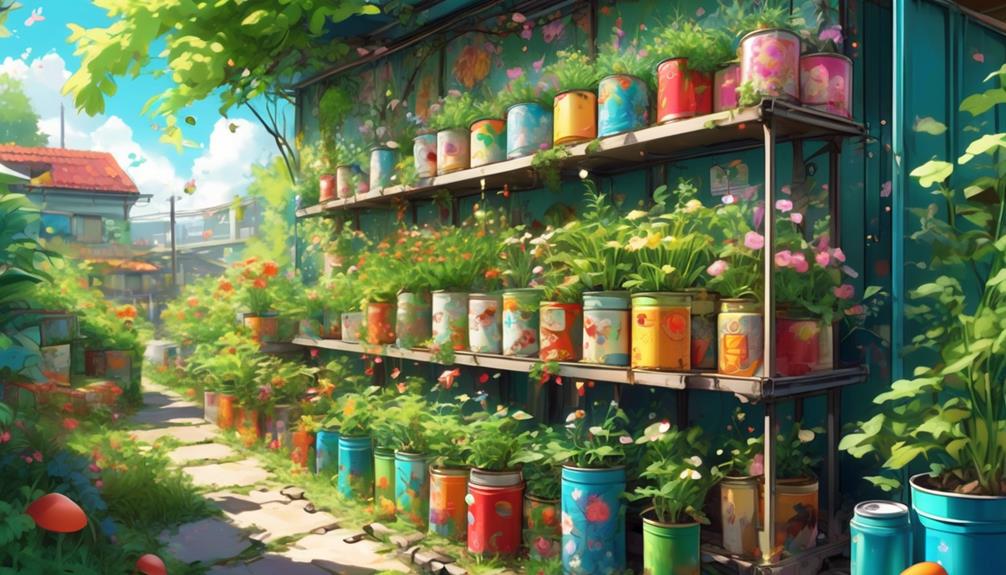Are you tired of throwing away plastic pots and trays after starting your seeds? Well, fret no more, because there are eco-friendly seed starting ideas using recycled materials that can help you reduce waste and give new life to everyday items.
From toilet paper rolls to newspaper pots, there are plenty of creative options that not only save you money but also contribute to a more sustainable gardening approach.
So, if you’re ready to discover these innovative seed starting methods, keep on reading to find out how you can make a positive impact on the environment while nurturing your plants.
Seed Starting Ideas…
- Seed starting with recycled paper products, such as toilet paper rolls and paper towel rolls, is a cost-effective and eco-friendly option.
- Repurposing supermarket veg trays as seed trays not only reduces plastic waste but also provides durable and stackable containers for easy storage.
- Plastic bottles can be repurposed into cloches for seedlings, providing protection and proper airflow.
- Upcycled outdoor planters, like sinks and bathtubs, create unique garden features while reducing waste and preventing materials from ending up in landfills.
Toilet Paper Roll Seed Starters
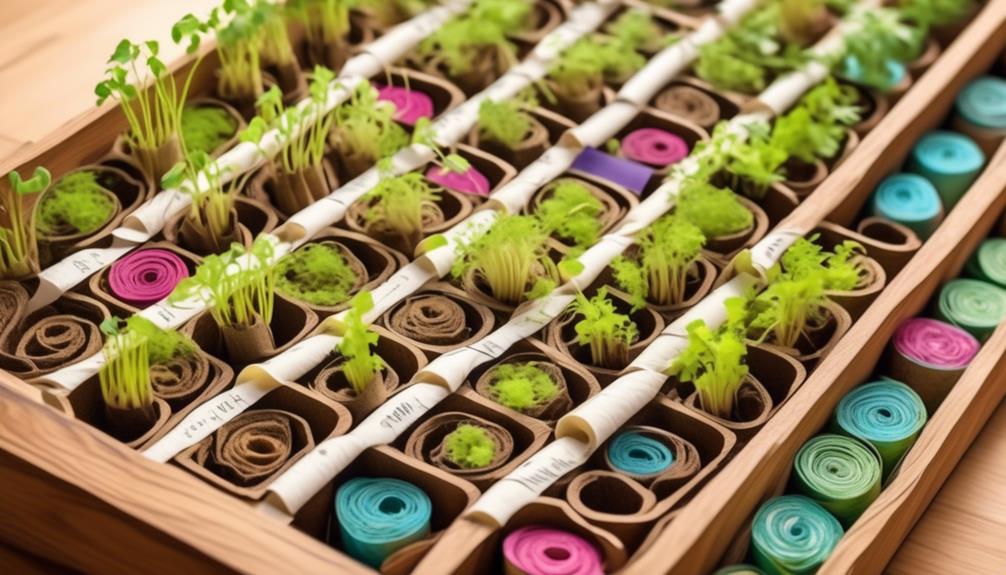
Toilet paper rolls make excellent seed starters for plants that dislike root disturbance, as they can be planted directly into the soil without removing the plant from the roll.
When using toilet paper rolls as seed starters, it’s recommended to peel back the tops of the roll before planting. This allows the plant to emerge easily once it starts growing.
To create a toilet paper roll seed starter, simply fill the roll with seed starting mix, which provides the necessary nutrients and moisture for the seeds to germinate.
It’s important to note that toilet paper rolls may start molding and breaking down before planting, but this isn’t a concern. In fact, the decomposition of the rolls can actually benefit the plants by adding organic matter to the soil.
Using recycled materials like toilet paper rolls as seed starter pots isn’t only eco-friendly, but it’s also an easy and cost-effective way to start your seeds. Plus, it gives a second life to something that would otherwise be thrown away.
Additionally, paper towel rolls can also be used as seed starter pots in the same way as toilet paper rolls. So, the next time you finish a roll of toilet paper or paper towels, consider repurposing them into seed starter pots for your garden.
‘Did You Know? The average person uses about 100 rolls of toilet paper per year.’
Supermarket Veg Tray Propagation
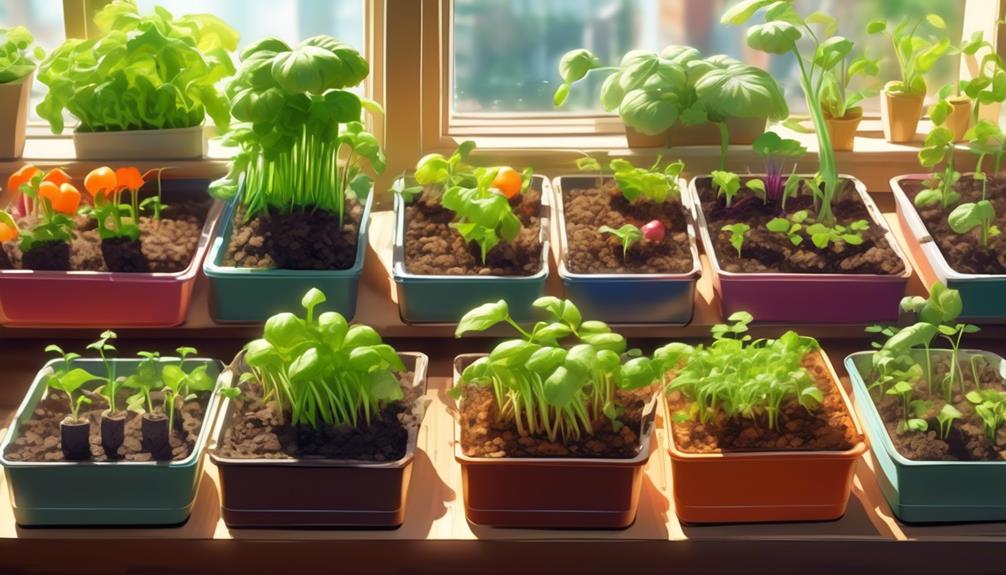
When looking for another sustainable and cost-effective option for starting your seeds, consider repurposing supermarket veg trays as seed trays.
These trays can be easily transformed into functional seed trays by adding drainage holes to the bottom. Supermarket veg trays are commonly available from mushroom, strawberry, and other fruit and vegetable packaging, making them easily accessible for repurposing.
Not only do these trays help reduce waste, but they also offer an eco-friendly seed starting solution.
Supermarket veg trays are durable and can be reused for multiple years, making them a sustainable choice for seed starting. They’re stackable, allowing for easy storage when not in use. By repurposing these trays, you can reduce your environmental impact and create unique planters for your garden.
Using supermarket veg trays as seed trays is a cost-effective option as well. Instead of purchasing individual seed trays or plastic berry containers, you can repurpose these recycled containers to start your seeds. This not only saves money but also reduces the amount of plastic waste generated.
Newspaper Pot Seed Starting
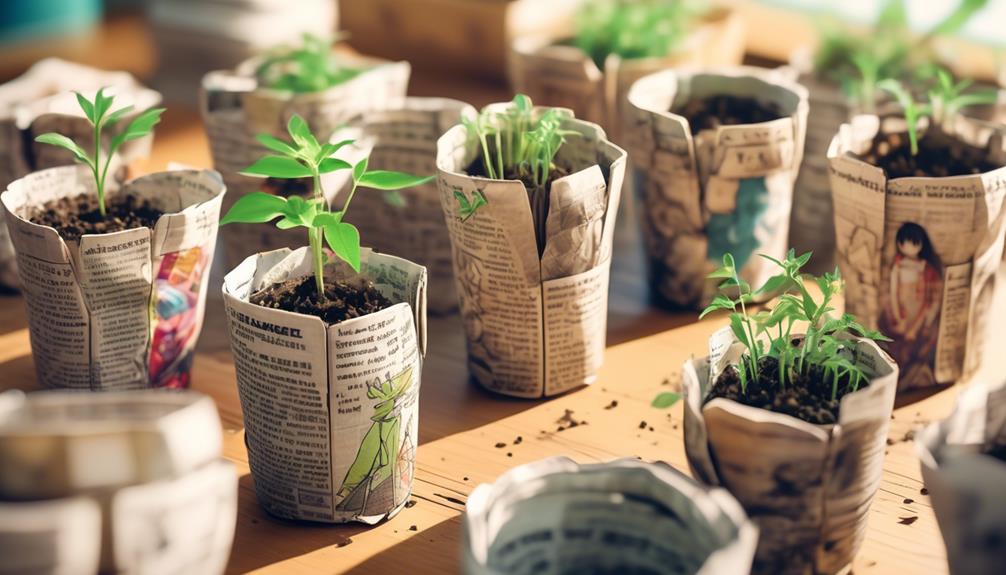
To start your seeds in an eco-friendly and cost-effective way, consider using newspaper pots. This DIY project allows you to repurpose old newspapers and reduce waste while providing a sustainable option for starting your seeds.
Here are four reasons why newspaper pots are a great choice for seed starting:
- Environmental Benefits: By using newspaper pots, you’re recycling and reusing materials that would otherwise end up in the landfill. This eco-friendly approach contributes to a more sustainable gardening practice.
- Biodegradable and Safe: Newspaper and ink are safe for your garden. The pots will naturally break down over time, allowing the roots to penetrate the pot and minimizing transplant shock when it’s time to move your seedlings to the garden.
- Cost-effective: Making newspaper pots is a cost-effective alternative to purchasing traditional plant pots or seedling trays. You can easily create as many pots as you need using materials you already have at home.
- Fun and Engaging: Newspaper pot seed starting can be a fun and educational activity for both children and adults. It offers a chance to learn about sustainability while nurturing plants from seed to maturity.
Paper Cup Seed Starter
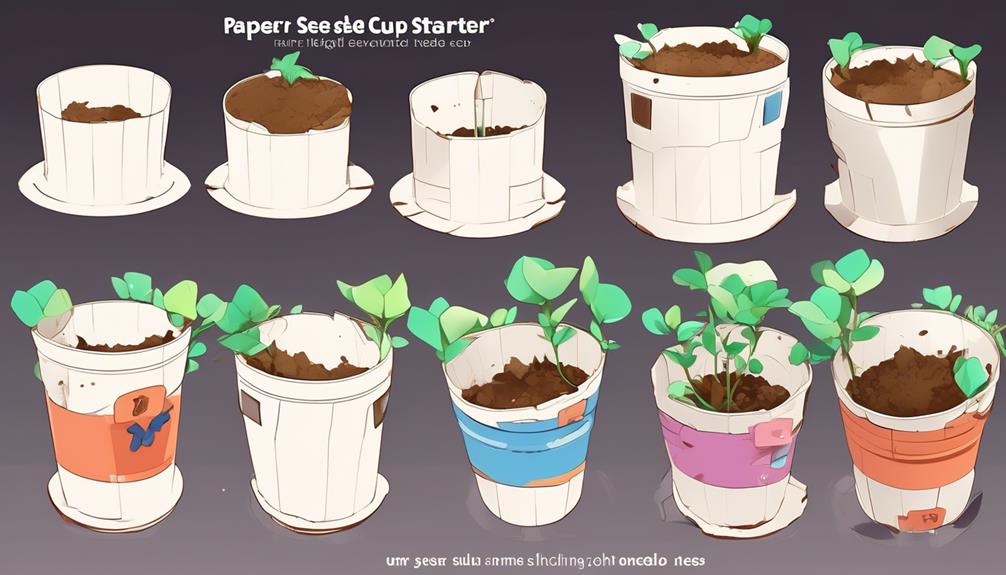
If you’re looking for another eco-friendly option for starting your seeds, consider using paper cups as pots. These pots aren’t only durable but are often made from recycled materials, making them a sustainable choice.
To create a paper cup seed starter, look for unwaxed paper cups and make a drainage hole in the bottom for proper water management.
You can easily obtain leftover cups from local coffee shops, which not only helps reduce waste but also saves you money. Additionally, you can enhance the eco-friendly aspect of paper cup seed starters by utilizing spent coffee grounds for gardening and composting.
Paper cups provide a sturdy alternative to other seed starting options like toilet paper rolls and newspaper pots. They offer a reliable and cost-effective solution that promotes sustainability in your gardening practices.
Pastry or Salad Clamshell Propagators
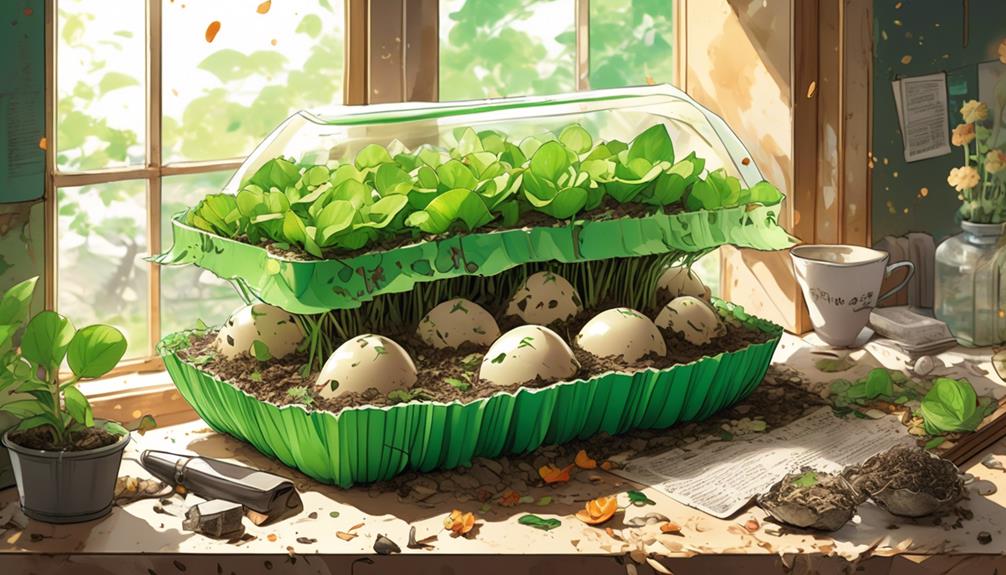
Clamshell propagators are a simple and cost-effective way to start seeds using plastic containers from bakery items. These containers, commonly known as clamshells, are often used for packaging items like pastries or salads and can be repurposed for seed starting.
Here are the steps to create a clamshell propagator for starting seeds:
- Collect Clamshell Containers: Gather plastic clamshell containers from bakery items. Make sure they are clean and free from any food residue.
- Prepare Drainage Holes: Using a sharp object like a knife or a heated skewer, create small drainage holes in the bottom of each container. These holes will allow excess water to drain out and prevent waterlogging the seeds.
- Fill with Seed Starting Mix: Fill each clamshell container with a high-quality seed starting mix. This mix should be light, well-draining, and sterile for optimal seed germination and growth.
- Plant Seeds: Follow the seed packet instructions for planting depth and spacing. Place the seeds on top of the seed starting mix and cover them with a thin layer of the mix. Gently press the soil to ensure good seed-to-soil contact.
- Water and Cover: Water the seeds thoroughly, making sure the soil is evenly moist. Place the lid of the clamshell container on top to create a mini greenhouse effect and retain moisture. The lid will also help to maintain a stable humidity level.
- Provide Proper Lighting and Temperature: Place the clamshell propagators in a warm and well-lit location. Seeds generally require a temperature range of 65-75°F (18-24°C) for optimal germination. If needed, use a grow light or place the propagators near a sunny window to provide adequate light.
- Monitor and Maintain Moisture: Regularly check the moisture level of the soil by gently pressing it with your finger. If it feels dry, mist the soil with water to keep it moist but not waterlogged. Avoid overwatering, as it can lead to seed rot and fungal diseases.
- Ventilation: As soon as the seedlings emerge, gradually increase ventilation by slightly opening the clamshell lid. This will help acclimatize the seedlings to the surrounding environment and prevent damping-off disease caused by excessive humidity.
- Transplanting: Once the seedlings have developed a few sets of true leaves and are strong enough, they can be transplanted into larger containers or into the ground for further growth.
Clamshell propagators allow for easy monitoring of seedling progress, provide a controlled environment, and help retain moisture for successful germination.
They are an excellent option for repurposing plastic containers from bakery items and are especially useful for small-scale seed starting projects.
Water Dispenser Cloches
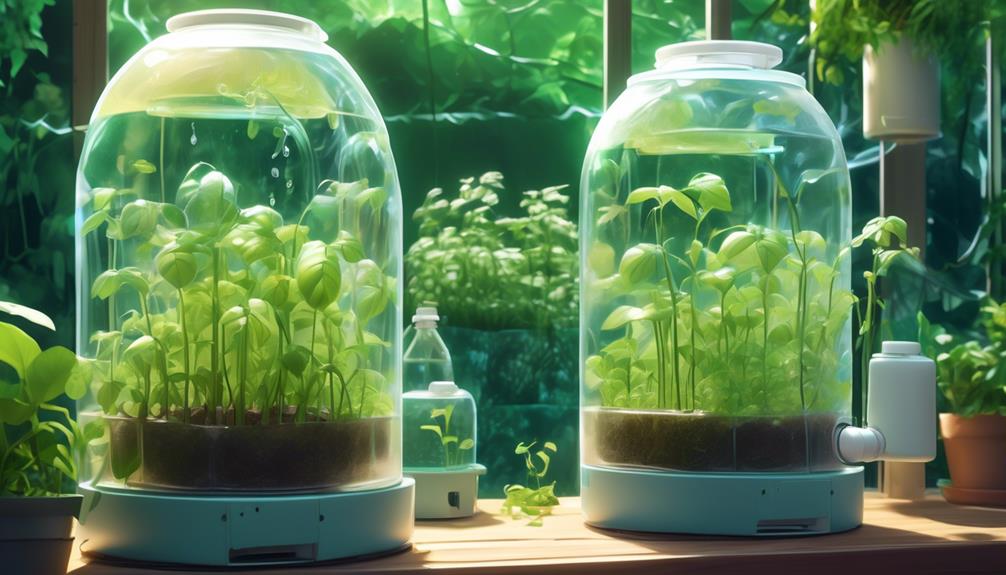
When it comes to eco-friendly seed starting, one clever idea is the use of water dispenser cloches. These cloches provide individual plant protection in the form of mini-greenhouses.
To make them, simply take large water bottles and remove the bottoms.
This repurposes the plastic bottles and reduces waste. The cloches keep your seedlings warm and protect them from slugs and snails, ensuring their healthy growth.
By recycling and using these water dispenser cloches, you aren’t only being eco-friendly, but also saving money on purchasing individual plant protectors.
To use the water dispenser cloches, place them over your seedlings, making sure they’re securely in the soil or pots.
The cloches create a warm and moist environment, perfect for seed germination and early growth. They also act as a barrier, preventing pests from damaging your plants.
Additionally, the clear plastic allows sunlight to penetrate and nourish your seedlings.
Water dispenser cloches are an excellent example of using recycled materials for gardening purposes. They’re a creative and practical solution that helps reduce waste.
So, the next time you finish a large water bottle, don’t throw it away. Instead, repurpose it into a water dispenser cloche and give your seedlings the protection they need to thrive.
Plastic Bottle Cloches
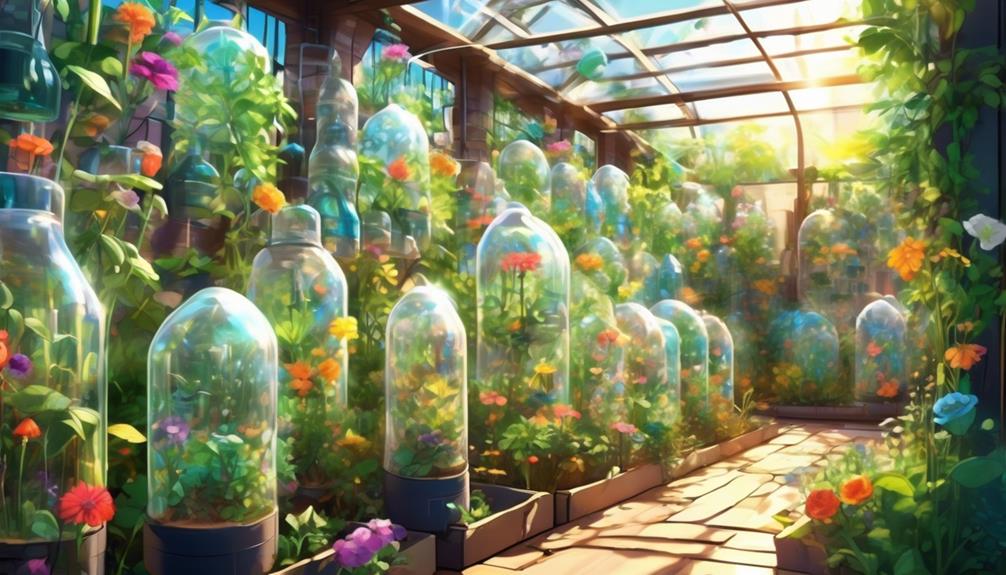
Plastic bottle cloches offer a practical and eco-friendly solution for protecting individual plants in a mini-greenhouse setup. Here are four reasons why plastic bottle cloches are a great option for seed starting using recycled materials:
- Cost-effective: Plastic bottles are readily available and can be repurposed into cloches without spending extra money. Instead of buying expensive seed starting trays, you can use plastic bottles that you already have at home.
- Versatile: Plastic bottle cloches can be used for a variety of seedlings, including those planted in egg cartons or newspaper pots. Simply cut the bottom of the bottle and place it over the seedling, providing protection from harsh weather conditions and pests.
- Improved airflow: By adding top ventilation to the plastic bottle cloche, you ensure proper airflow for the seedlings. This helps prevent the buildup of excess moisture and reduces the risk of fungal diseases.
- Easy transplanting: When it’s time to transplant your seedlings, you can plant the entire plastic bottle cloche directly into the ground. This eliminates the need to remove the seedling from the container, reducing transplant shock and saving time.
Upcycled Outdoor Planters
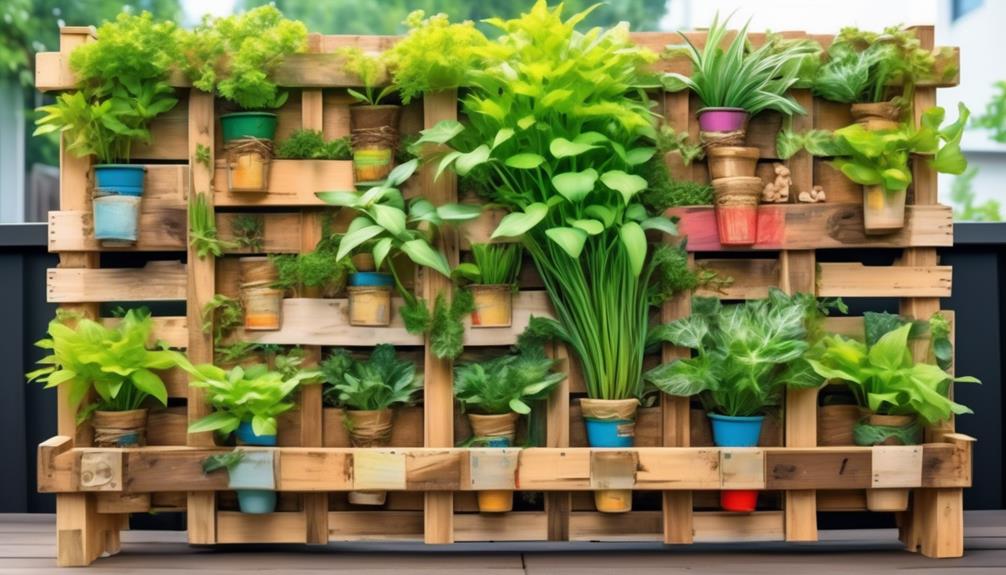
If you’re looking for another eco-friendly seed starting option that builds upon the concept of repurposing materials, consider exploring the world of upcycled outdoor planters.
These planters provide a sustainable and creative way to make use of recycled materials while starting your seeds.
You can repurpose old sinks and bathtubs as unique outdoor planters, giving your garden a distinctive and charming touch.
To ensure proper drainage, it’s important to make holes in these upcycled planters. This will allow excess water to escape and prevent your seeds from becoming waterlogged.
Once you have prepared the planters, fill them with soil and start planting your seeds. Upcycled outdoor planters are particularly great for growing herbs like rocket and coriander, as they provide a perfect growing environment.
By using upcycled planters, you not only reduce waste but also repurpose materials that would have otherwise ended up in a landfill. This makes it a sustainable gardening option that aligns with the principles of recycling and reducing our environmental impact.
So go ahead and get creative with your upcycled planters, and enjoy the benefits of starting your seeds in a unique and environmentally friendly way.
‘Did You Know? Upcycling not only reduces waste, but it can also save you money by repurposing materials you already have instead of buying new ones.’
Eco Friendly Seed Starting…
In the garden of sustainability, these eco-friendly seed starting ideas using recycled materials are like seeds of hope. They not only save money and repurpose materials, but also reduce waste and contribute to a greener world.
From toilet paper roll starters to upcycled outdoor planters, these unique and biodegradable alternatives provide a nurturing environment for seeds to grow. By embracing these environmentally friendly choices, we can cultivate a healthier planet, one seed at a time.
